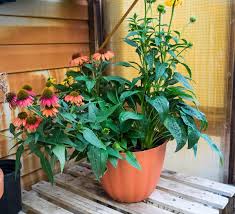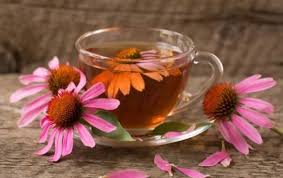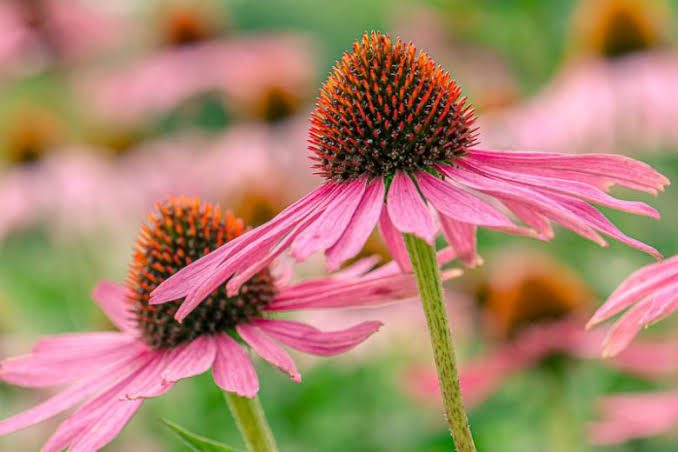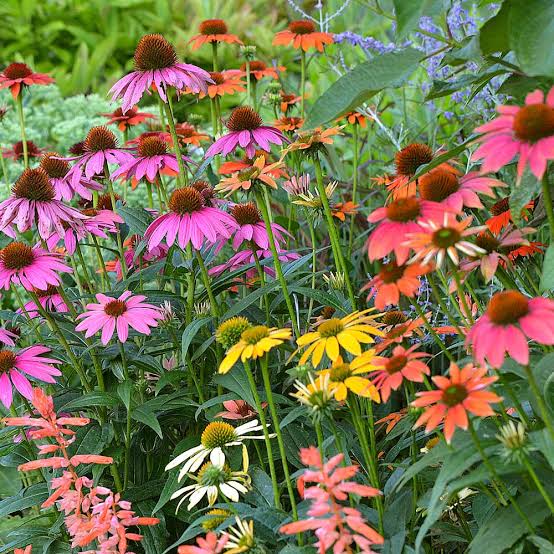Echinacea Tea is a type of herbal tea made from the Echinacea plant. Echinacea is a pretty flower that grows in North America and is famous for its medicinal properties. People have been using Echinacea for a long time to help with various health issues.
To make Echinacea Tea, you don’t need a lot of fancy stuff. First, you take the Echinacea plant’s roots, leaves, or flowers, and then you put them in hot water. Let the hot water soak up all the good stuff from the Echinacea plant, and voila, you have Echinacea Tea.
Now, let’s talk about why Echinacea Tea is so cool. People drink it because they think it can help them when they feel sick. Some folks believe that Echinacea Tea can boost their immune system, which is like their body’s superhero that fights off bad germs.
Echinacea Tea is also a friend to your throat. When your throat feels scratchy and not so great, sipping on a cup of Echinacea Tea can be soothing. It’s like giving your throat a warm, cozy blanket to snuggle in.
Sometimes people take Echinacea Tea when they have a cold or flu. They hope it will help them feel better faster. But remember, Echinacea Tea isn’t a magic potion. It might help a little, but it won’t make you instantly all better. Some people even use Echinacea Tea for their skin. They say it can help with things like acne or other skin problems. It’s like a gentle hug for your skin.
Echinacea Tea has been around for a while, and people still love it. It’s easy to make, and it can be a comforting friend when you’re not feeling your best. Just remember, if you’re not sure if Echinacea Tea is right for you, it’s a good idea to talk to a doctor or a wise herbalist. They can give you the best advice for your health.
Echinacea Tea in simple words is like a warm, healing hug in a cup, made from a pretty flower that’s been helping people for a long, long time. Give it a try when you’re feeling under the weather, and it might just become your new favorite tea.
Read Also: How to Extract and Package Snail Slime (Snail filtrate) for Commercial Use
How to Grow Echinacea Plant (Flower)

Growing Echinacea, also known as purple coneflower, can be a fun and rewarding experience. These pretty flowers not only add beauty to your garden but can also attract pollinators like bees and butterflies. In this simple guide, we will show you how to grow Echinacea successfully.
1. Choose a Sunny Spot: Echinacea loves sunshine! Pick a place in your garden that gets at least 6 hours of sunlight each day. This will make your Echinacea plants happy and healthy.
2. Prepare the Soil: Echinacea is not picky about soil, but it prefers well-drained soil. If your soil doesn’t drain well, you can add some sand to help with drainage. Mix in some compost too, as Echinacea likes nutrient-rich soil.
3. Planting Echinacea Seeds or Plants: You have two options: planting seeds or getting young Echinacea plants from a nursery. If you choose seeds, plant them in the spring or early summer. If you go for young plants, you can plant them in spring or fall. Make a hole in the soil about as deep as your finger and put the seed or plant in. Cover it with soil and pat it gently.
4. Watering: Echinacea doesn’t need tons of water. Water it when the soil feels dry to the touch, but don’t let it sit in soggy soil. Water the base of the plant, not the leaves.
5. Mulch: Spread a layer of mulch around your Echinacea plants. This helps keep the soil moist and prevents weeds from growing. Mulch can be like a cozy blanket for your Echinacea.
6. Watch for Flowers: Echinacea plants usually start flowering in their second year. The flowers can be pink, purple, or white. They look like cone-shaped hats. When they bloom, they also attract bees and butterflies.
7. Deadheading: After the flowers fade, you can snip them off. This is called deadheading. It helps your Echinacea plants focus their energy on making more flowers instead of seeds.
8. Winter Care: In the winter, Echinacea can handle the cold, but if you live in a super chilly place, you can cover the plants with mulch to protect them.
9. Divide and Share: Echinacea plants can get big over the years. You can dig up the plant, split it into smaller pieces, and replant them in other parts of your garden or share them with friends.
Growing Echinacea is like having a cheerful friend in your garden. They’re not too demanding, and they bring a burst of color and life. So, find a sunny spot, give them some well-draining soil, and watch your Echinacea bloom and thrive.
10 Health Benefits of Drinking Echinacea Tea

Here are 10 health benefits of Echinacea Tea:
1. Immune System Boost: Echinacea Tea is believed to help strengthen your immune system, making it better at fighting off colds and infections.
2. Cold and Flu Relief: Many people turn to Echinacea Tea when they have a cold or the flu because it might reduce the severity and duration of symptoms.
3. Respiratory Health: Echinacea Tea can be soothing for your throat and may help ease symptoms of respiratory infections like sore throats and coughs.
4. Anti-Inflammatory: It has anti-inflammatory properties that could assist in reducing inflammation in the body, which is linked to various health issues.
5. Antioxidant Power: Echinacea Tea contains antioxidants that can protect your cells from damage caused by harmful molecules called free radicals.
6. Skin Health: Some people use Echinacea Tea topically to help with skin problems like acne and eczema due to its potential anti-inflammatory effects.
7. Pain Relief: It may offer mild pain relief, making it helpful for headaches, joint pain, and other minor aches and pains.
8. Digestive Aid: Echinacea Tea can have a calming effect on the digestive system, potentially helping with issues like indigestion and upset stomach.
9. Stress Reduction: The act of sipping a warm cup of Echinacea Tea can be relaxing, which may help reduce stress and anxiety.
10. Allergy Relief: Some people find relief from seasonal allergies by drinking Echinacea Tea because it may reduce allergy symptoms.
Remember that while Echinacea Tea offers these potential benefits, it’s not a cure-all, and individual responses can vary. If you have any specific health concerns or are taking medications, it’s a good idea to consult with a healthcare professional before making Echinacea Tea a regular part of your routine.
Rwad Also: The Different Crop Storage Methods
Echinacea Purpurea

Echinacea purpurea is a beautiful and useful plant. Many people call it the purple coneflower because of its pretty pinkish-purple petals. This plant is native to North America, which means it naturally grows there.
People love Echinacea purpurea for its health benefits. Some say it can help boost your immune system, which is like your body’s defense team against germs. When your immune system is strong, you are less likely to get sick.
You can find Echinacea purpurea in gardens and even in some herbal remedies. It’s easy to grow in your garden if you like colorful flowers. All you need is some good soil, water, and sunlight. Just like you, this plant likes a healthy environment.
Echinacea purpurea is also used in traditional medicine by some Native American tribes. They used it to treat various illnesses. Even today, some people use it as a natural remedy when they have a cold or a sore throat.
The roots, leaves, and flowers of this plant are all useful. You can make tea from its leaves and flowers. Some people believe this tea can help them feel better when they are not well. Others use it as a way to relax and enjoy a warm drink.
Echinacea purpurea can also attract helpful insects like butterflies and bees to your garden. These insects help pollinate plants, which means they help plants make more seeds. More seeds mean more plants in the future.
In addition, Echinacea purpurea is a lovely plant that grows in North America. It’s known for its immune-boosting properties and has been used in traditional medicine for a long time. You can even grow it in your garden and enjoy its beauty while it helps your local ecosystem.
Echinacea Flower

Echinacea flowers are a beautiful and unique type of flower. They belong to the Echinacea genus and are often referred to as coneflowers due to their distinctive shape. These flowers are native to North America and are known for their vibrant and striking appearance.
Echinacea flowers come in various colors, but the most common ones are shades of pink and purple. They have a prominent, cone-shaped center that is surrounded by delicate petals. This cone is made up of tiny individual flowers packed closely together, creating a spiky appearance. The petals radiate outward, forming a charming and eye-catching display.
One of the remarkable things about Echinacea flowers is their ability to attract pollinators such as bees and butterflies. These insects are drawn to the bright colors and nectar-rich blooms of Echinacea. As they visit the flowers in search of food, they inadvertently transfer pollen from one flower to another, aiding in the plant’s reproduction.
Echinacea flowers are not only aesthetically pleasing but also have a place in herbal medicine. Some people use Echinacea extracts for their potential health benefits, believing they may help boost the immune system and support overall wellness. While more research is needed to confirm these claims, the cultural and historical significance of Echinacea in herbal remedies is noteworthy.
In gardens and landscapes, Echinacea flowers are a popular choice due to their hardiness and ability to thrive in various climates. They require well-drained soil and plenty of sunlight to flourish. Gardeners appreciate these flowers for their low maintenance and the burst of color they bring to their outdoor spaces.
Echinacea flowers are captivating and resilient blooms native to North America. Their distinctive appearance, vibrant colors, and role in attracting pollinators make them a cherished addition to gardens and natural landscapes. Additionally, their historical use in herbal medicine adds to their allure, making them a symbol of beauty and potential health benefits.
Echinacea Seeds
Echinacea seeds are tiny but mighty, holding the potential to grow beautiful and beneficial Echinacea plants. These seeds are the starting point for cultivating Echinacea, also known as coneflowers, in your garden or landscape.
Here are things you need to know about Echinacea seeds:
1. Varieties: Echinacea comes in different species and varieties, each with its unique seed characteristics. Common species include Echinacea purpurea (purple coneflower) and Echinacea angustifolia. Varieties may vary in flower color, size, and growth habits.
2. Collection: Echinacea seeds can be collected from mature Echinacea flowers. As the flowers fade, they develop seed heads, which contain the seeds. You can gently shake or tap the dried seed head to release the seeds. Collect them in a container for future planting.
3. Sowing: Planting Echinacea seeds is a straightforward process. You’ll want to sow them in well-draining soil in either the spring or early fall. Lightly cover the seeds with soil and keep the area moist until germination, which typically takes one to three weeks.
4. Sunlight: Echinacea plants thrive in full sunlight, so choose a location in your garden that receives at least six hours of direct sun each day.
5. Watering: Keep the soil consistently moist but not waterlogged during the germination period. Once the plants are established, they are quite drought-tolerant and only need occasional watering.
6. Growth: Echinacea seeds will sprout into small seedlings that will gradually develop into mature plants. Depending on the species and growing conditions, it may take a year or more for them to reach full maturity and start producing their signature coneflower blooms.
7. Maintenance: Echinacea plants are relatively low-maintenance. Prune dead flower heads to encourage more blooms and remove any diseased or damaged foliage. They are also generally resistant to pests and diseases.
8. Benefits: Echinacea plants are not only visually appealing but are believed by some to have immune-boosting properties. The roots, leaves, and flowers of Echinacea have been used in herbal remedies for their potential health benefits, although more research is needed to confirm these claims.
Additionally, Echinacea seeds are the first step in growing these beautiful and potentially beneficial plants. With proper care and patience, you can enjoy their colorful blooms and possibly explore their herbal uses in your garden.
Echinacea Goldenseal
Echinacea Goldenseal is a combination of two powerful herbs; Echinacea and Goldenseal. These herbs have been used for centuries for their various health benefits.
Echinacea, also known as the purple coneflower, is a beautiful flower native to North America. It has been traditionally used by Native American tribes to boost the immune system. Imagine your body as a fortress, and Echinacea is like the strong walls that protect it. It helps your immune system fight off invaders like colds and flu. Echinacea is often taken in the form of teas, capsules, or tinctures.
Goldenseal, on the other hand, is a plant with vibrant yellow roots. It is another Native American remedy that has been cherished for its healing properties. Goldenseal can be thought of as a helpful scout. It searches out trouble in your body and helps to calm it down. It’s particularly known for its ability to soothe irritation in the mucous membranes, which are like the body’s delicate inner linings.
Now, let’s see why these two herbs work so well together. When Echinacea and Goldenseal join forces, it’s like having a strong army with skilled healers. Echinacea boosts your defenses, while Goldenseal goes to the source of the problem and helps to ease discomfort.
Together, they can be used for various health concerns which are:
1. Immune Support: Echinacea Goldenseal is a popular choice during cold and flu season. It helps your body fend off those pesky viruses and bacteria.
2. Respiratory Health: If you’re dealing with a cough or stuffy nose, Echinacea Goldenseal can provide relief by calming irritated airways.
3. Digestive Harmony: Goldenseal’s soothing nature can be helpful for digestive issues. It helps calm down an upset stomach.
4. Wound Healing: Some people use Echinacea Goldenseal topically to aid in the healing of minor wounds and skin irritations.
5. General Well-being: Even if you’re not feeling under the weather, Echinacea Goldenseal can help support overall health by fortifying your immune system.
When using Echinacea Goldenseal, it’s essential to follow the recommended dosage on the product label. Like any natural remedy, it’s not a one-size-fits-all solution, and individual responses can vary.
Additionally, Echinacea Goldenseal is a dynamic duo of herbs that have been trusted for generations. They work together to help your body stay strong and resilient against various health challenges.
Whether it’s boosting your immunity, soothing a sore throat, or aiding digestion, Echinacea Goldenseal can be a valuable addition to your wellness toolkit. Remember, nature often provides simple solutions for our well-being, and Echinacea Goldenseal is a shining example of that wisdom.
Read Also: How to Make Money from Styrofoam Recycling
